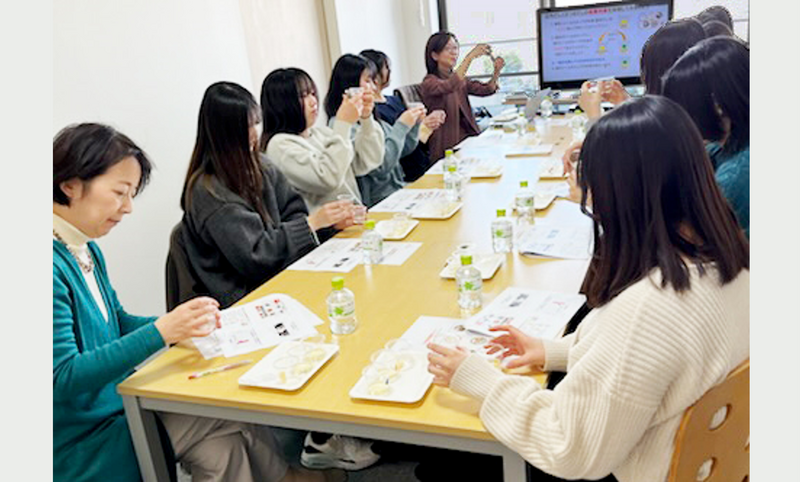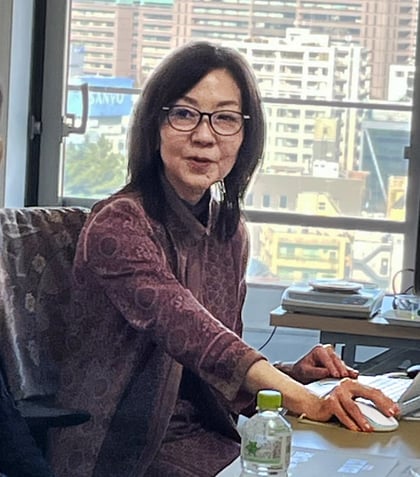Umami Lecture to the Students of Otsuma Women’s University
January 2025

“I found that there is a proper amount of umami substance to make each dish delicious . Maybe I put too much umami seasoning in. Now my bouillon tastes like potato snacks!”. This is an honest comment of a college student who added what she thought was the “right amount” of umami seasoning to her vegetable bouillon.
On January 24, 2025, the Food Science Seminar, a regular lecture of Otsuma Women's University, was held at the Umami Information Center (UIC) to third-year students enrolled in the Faculty of Home Economics at the university. The lecture was given by UIC Director Yasue Kido, and 10 seminar students of Professor Miho Otahara of Otsuma Women's University came to the UIC to attend it.

Considering that the participants were students who will use their expertise in food science in the near future, Yasue Kido introduced useful contents on the UIC's official website, such as “Umami Rich Ingredients*” and “the Umami Database*,” which would be useful for them.
She shared the scientific knowledge of umami, from basic to advanced including its effects on health. She made this exercise an opportunity to learn about umami from multiple angles by including tasting and simple exercises to help the participants experience umami as a taste sensation.
In the tasting session, students tasted umami-rich foods such as a dried tomato and cheese to confirm the three characteristics of umami: “Spreading across the tongue,” “Persistence,” and “Promotes salivation." The students also tasted kombu (kelp) dashi with amino acid-based umami and katsuo (bonito) dashi with nucleic acid-based umami to sense the umami synergy.
The students then compared the two types of vegetable bouillon. One was a bouillon with little umami and saltiness, and the other was a same vegetable bouillon with umami substance added. In this way, they realized the effect of adding umami substances. They sensed the effect of the addition of umami saying, “When I add it, the taste seems to become richer” or “It seems to become sweeter.
Umami seasonings, which can easily add umami to your cooking, are very convenient if used appropriately. However, as with salt, sugar, and other seasonings, there is a proper amount to use. In general, you only need a small amount of umami seasoning to get the desired effect compared to sugar or salt.
Students experienced this at the end of the practical works. They added what they thought was the “right amount” of umami seasoning to the vegetable bouillon they had just tasted, which contained little salt and little umami. The student's comment shown at the beginning of the lecture is from this time.
Some added a few sprinkles of umami seasoning, and others just a little, but each was surprised at the effect and seemed to have thought about the proper amount of umami seasoning.
We received various other comments. Here are some of them. We believe that the students learned about umami with a real sense of taste.
・The effect of umami was well understood, but I added too much umami seasoning to the vegetable
bouillon in the last experiment. It left an unpleasant aftertaste.
・I believed that it is the taste of katsuo that determines the deliciousness of dashi. But when I tasted
katsuo dashi on its own, the taste was different from what I had imagined.
I learned that the deliciousness of dashi can be realized in combination with kombu dashi.
・I was surprised to know that glutamate is also contained in breast milk.
・I want to share what I learned today with others.
The students are hoping to work in food companies, elderly facilities, hospitals, food service providers, and many other places. We hope that they will make use of their knowledge of umami in their respective careers.
*UIC website
Umami Rich Ingredients: https://www.umamiinfo.com/richfood/
Umami Database: https://www.umamiinfo.com/umamidb/
